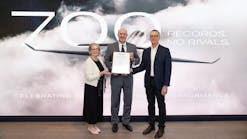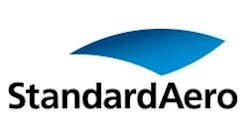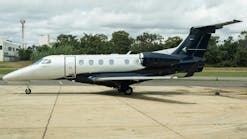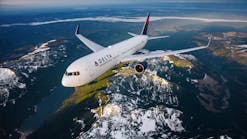Boosting Your Knowlege of Turbocharging
Part II -Valves and Controllers
By Randy Knuteson
October 1999
All normally aspirated aircraft engines gain altitude at the expense
of horsepower. Approximately three percent of horsepower is lost or traded for every 1,000 feet of altitude gained; as altitude increases, performance wanes. The obvious advantage of any turbocharged aircraft is its ability to compensate for this loss and provide maximum rated power at altitude. This advantage gives the pilot the ability to over-climb inclement weather, achieve optimum altitudes and attain maximum speeds with relative ease. To fly high and fast in a pressurized cabin while experiencing smooth air and favorable winds is very desirable. Reduced drag, increased range, and improved fuel economy are just a few of the benefits turbocharging offers.
In our previous discussion (July issue of AMT), we focused solely on the turbocharger itself — that component which at altitude supplies additional power to otherwise anemic performing engines. We determined that pulsing exhaust gases provide the requisite force to drive the turbine wheel and consequently, the compressor, to speeds of up to 2,000 revolutions per second. The end result — exhaust energy is converted to manifold pressure. We also discovered that the turbocharger is subjected to the extremes of temperatures and duty cycles and that consistent oil changes, cool-down practices and maintenance are essential to its continued performance, health and operation.
Turbochargers are indeed a remarkable feat of engineering ingenuity. And when coupled with their supporting wastegates, controllers, relief valves, oil lines and piping they can seem both confusing and intimidating. Occasionally, even the seasoned mechanic becomes frustrated to the point of literally "throwing in the wrench" on these systems. However, armed with just a bit of knowledge, charge-air systems can be reduced from extremely daunting to simply challenging. Perhaps the following information will equip you to feel up to the challenge as we attempt to clarify some of the annoying and at times confusing nuances of turbocharging systems. Our discussion will focus on the individual components coupled with an explanation as to how they interrelate to each other.
Pressures to Perform
As their names suggest, Valves and Controllers both regulate and control turbocharger discharge pressure. This is an exacting science due to the fact that there is a disproportionate air/fuel ratio that must be tailored to the ever-changing demands of the engine as well as atmospheric density changes. For these reasons, a means of managing this forced air-flow to the cylinders is necessary to prevent the onset of detonation or overboost. The control portion of the turbocharging "system" was designed for this purpose. Valves and controllers provide the desired flight envelop, while keeping engine intake manifold temperatures and exhaust manifold pressures as low as possible.
Deck Pressure and Manifold Pressure
A basic knowledge of the air pressures associated with turbocharging
is necessary for a more thorough understanding of these control systems. Air upstream of the throttle plate is often referred to as "Upper Deck Pressure." Deck pressure is measured between the compressor discharge and the inlet to the fuel injector or carburetor. Pressure downstream of the throttle is referred to as "Manifold Pressure" and is referenced between the throttle plate and the cylinder intake. On average, there is a pressure drop of approximately two inches of mercury across the throttle plate depending upon throttle position. Deck pressure always exceeds manifold pressure. At wide-open throttle, the air pressure drop across the throttle plate is at its minimum. And conversely, as the throttle is closed, this pressure drop increases. These pressures change both in response to throttle movements and variations in air density and temperatures.
The need to control
Intake air pressures and temperatures must be controlled since they have such a direct influence on engine performance. The Controller's purpose is twofold: to sense changes in the upper deck and intake manifold pressures and to keep engine power constant as ambient conditions vary. Some engines rely on more than one controller to perform this task. Controllers may be found in multiples or combined in a common housing. Regardless of the arrangement, they operate in parallel, even while responding to differing stimuli. Depending upon their installation, controllers may be plumbed directly into the upper deck air-stream or remotely mounted and referenced by means of hoses.
Automatic controllers
The automatic controller monitors deck, manifold, and/or ambient pressures
by means of a pressure differential across the diaphragm or by using a bellows calibrated to a predetermined absolute pressure. As the controller senses pressure changes, it seeks to modulate turbo output by regulating the amount of oil allowed to bleed past a poppet valve also housed within the controller. The movements of the diaphragm or the expansion and contraction of the bellows within the controller alters the position of this oil metering poppet valve in relation to a seat. As this poppet closes, oil flow back to the sump is restricted. Oil begins to dam upstream and exert a force against a piston in the wastegate actuator. This piston is mechanically linked to the wastegate valve and begins to close the valve. As the controller poppet moves, it becomes an adjustable orifice regulating the buildup of oil pressure that is exerted against a piston in the wastegate actuator. By altering the position of the wastegate valve, it controls the amount of exhaust gases either routed to the turbo or diverted out the exhaust, thus maintaining a pre-selected manifold pressure setting (see diagram 1, previous page.). In this manner it
schedules the appropriate amount of air to the engine at any given altitude or power setting.
The controller(s) could be appropriately thought of as the brains or command center for the entire charge-air system. As engine power, speed, or altitude is changed, the controller constantly strives for equilibrium within the system. The exhaust bypass valve (wastegate assembly) simply acts as a slave to the dictates of the controller. Engine oil becomes the muscle of the system, providing the power to actuate the movements of the wastegate assembly.
Design differences
Lycoming engines utilize four basic styles of controllers: the Differential,
the Density, the Variable Pressure and the Slope Controllers. The density controller is the only controller capable of sensing changes in temperature. It relies on a bellows charged with dry nitrogen to accomplish this purpose.
Density controllers are found in the Piper Navajo and Chieftain and a handful of helicopter applications. In the Piper, the density controller modulates the wastegate movement at wide open throttle while a differential controller keeps deck pressures from exceeding manifold pressures by more than a specified amount at part throttle settings. Density controllers are extremely sensitive to in-field adjustments. A 1/16th turn of the adjustment screw will result in a 2-in. change in manifold pressures. A thermocouple probe referenced to deck temperature is required when setting up these systems (see Lycoming S.I. No. 1187J).





